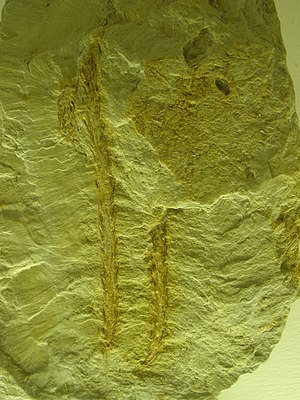Grès à Voltzia
The Grès à Voltzia is a sedimentary formation of the upper red sandstone of the Vosges . It is characterized by its fossil insect fauna .
etymology
The Grès à Voltzia, in German Voltziensandstein ( French grès "sandstone"), is named after the extinct conifer genus Voltzia that is typical for it .
Occurrence
The Grès à Voltzia occurs between Bitche , Baccarat and Épinal in the band of red sandstone that girdles the Vosges to the west. In the Palatinate and Saarland it is known as Voltziensandstein.
stratigraphy
The Grès à Voltzia concordantly follows the Couches intermédiaires (Couches violettes - in Germany intermediate layers ) and is in turn overlaid by the Grés coquilier of the shell limestone . The formation is around 20 meters thick. It is divided into two layers, the Grès à Voltzia Inférieur and the Grès à Voltzia Supérieur .
Grès à Voltzia Inférieur
The lower part of the layer, also known as Grès à meules , is made up of two different fluvial facies , similar to the Grès vosgien :
- River bed facies
- Overflow facies
River bed facies
The river bed facies consists of lenticular sandstone bodies. It is a fine-grained sandstone with no debris. On the layer surfaces there are sedimentary structures that document the changes in the flow regime in the course of floods, such as impact marks , grinding marks , ripple marks , etc. The sandstones also contain fossils, but these were generally broken during transport. Stegocephalic amphibian remains ( Temnospondyli ) and plant remains of ferns , horsetail and conifers were found.
The stone of the river bed facies has been a valued building block since the Middle Ages (the Strasbourg cathedral was built with it), which was also used as a grinding stone (hence grès à meules ).
Overflow facies
The much finer-grained overflow facies are made up of green or red claystones that were deposited under calm conditions after the flood event subsided from the overflowing flood. The overflow facies also contain fossils, but these are much better preserved compared to the river bed facies. The aquatic taxa include jellyfish , annelids , brachiopods such as. B. Lingula , horseshoe crabs , lamellibranchia , crustaceans , insect larvae and fish . Terrestrial organisms include spiders , scorpions , myriapods, and an enormous variety of insects. Only trace fossils (e.g. chirotherium ) have come down to us from reptiles . The flora is as in the Flussbettfazies of ferns, horsetails and conifers.
The occurrence of lingula points to changing salinity conditions and thus to the proximity of the sea to the deposit area. Thin calcareous / dolomitic layers with foraminifera and marine gastropods within the sandstones also point in the same direction.
Overall, the Grès à meules are likely to have been deposited near the shallow sea in a delta that was exposed to occasional sea advances.
Grès à Voltzia Supérieur
The Grès à Voltzia Supérieur, also known as Grès argileux , is already largely of marine origin. The sandstone banks reach a large horizontal extent in it, and the limestone layers are more frequent. The fossils found such as foraminifera , lamellibranchia, gastropods and cephalopods are clearly of marine origin.
The delta was now definitely inundated by the sea. Nevertheless, existing root rhizomes in the living position and traces of terrestrial reptiles indicate that the water depth is not too great and that the water has occasionally fallen dry.
Fossils

In addition to the fossils already mentioned, the Grès à Voltzia is known for its enormously diverse and well-preserved insect fauna. Louis Grauvogel alone has collected 5,300 insects from a total of 200 different taxa. In detail:
- Blattodea ( cockroaches ), including the species Voltziablatta grauvogeli and Voltziablatta intercalata
- Ephemeroptera ( mayflies ) - 7 species, mainly larvae
- Coleoptera ( beetles ) - 38 species
- Hemiptera ( crickets ) with Gallodunstania greyvogelana
- Diptera ( two-winged ) with Grauvogelia arzivilleriana
- Orthoptera ( jumping horror ) - 11 species including Galliagryllavia vogesiacus , Triassoparacyrtophyllites bifurcates , Voltziahagla pseudoveinosa and Triassophyllum leopardii
- Odonata ( dragonflies ) with Meganeura , Triadotype guillaumei and Voltzialestes triasicus
- Mecoptera ( beaked flies ) with Laurentiptera gallica , Pseudopolycentropus triasicus and Prochoristella pilosa
- Protorthoptera - meanwhile extinct order with 1 species
Clutches were also found.
The importance of this insect fauna lies in the fact that, in addition to archaic forms from the Paleozoic, it also has transitional forms between archaic and modern features; it also contains the first forerunners of modern forms as well as completely endemic taxa.
Age
The absolute age for the Grès à Voltzia is missing. As the uppermost formation of the Upper Buntsandstein, however, it can be assigned an age of 243 to 244 million years BP .
See also
swell
- Jean-Claude Gall: Le Grès des Vosges. Académie de Strasbourg

